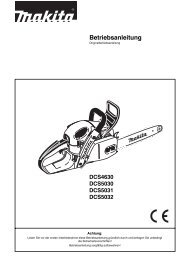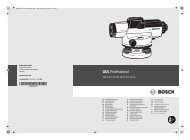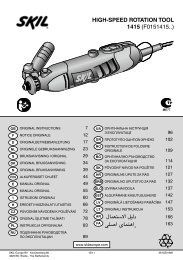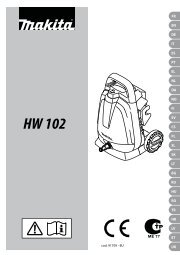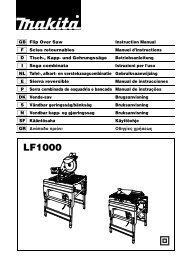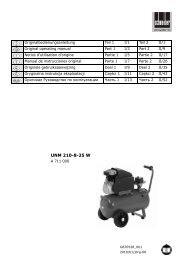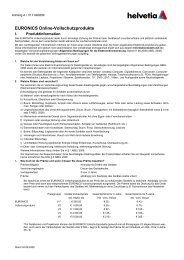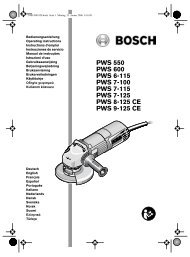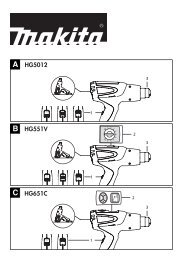Original Betriebsanleitung - Svh24
Original Betriebsanleitung - Svh24
Original Betriebsanleitung - Svh24
You also want an ePaper? Increase the reach of your titles
YUMPU automatically turns print PDFs into web optimized ePapers that Google loves.
OBJ_BUCH-819-002.book Page 13 Tuesday, July 17, 2012 1:55 PM<br />
English | 13<br />
Noise/Vibration Information<br />
Measured sound values determined according to EN 60745.<br />
Typically the A-weighted noise levels of the product are:<br />
Sound pressure level 93 dB(A); Sound power level<br />
104 dB(A). Uncertainty K =3 dB.<br />
Wear hearing protection!<br />
Vibration total values a h (triax vector sum) and uncertainty K<br />
determined according to EN 60745:<br />
Cutting board: a h =18.5 m/s 2 , K=1.5 m/s 2 ,<br />
Cutting wooden beam: a h =19.5 m/s 2 , K=1.5 m/s 2 .<br />
The vibration emission level given in this information sheet has<br />
been measured in accordance with a standardised test given in<br />
EN 60745 and may be used to compare one tool with another.<br />
It may be used for a preliminary assessment of exposure.<br />
The declared vibration emission level represents the main applications<br />
of the tool. However if the tool is used for different<br />
applications, with different accessories or poorly maintained,<br />
the vibration emission may differ. This may significantly increase<br />
the exposure level over the total working period.<br />
An estimation of the level of exposure to vibration should also<br />
take into account the times when the tool is switched off or<br />
when it is running but not actually doing the job. This may significantly<br />
reduce the exposure level over the total working period.<br />
Identify additional safety measures to protect the operator<br />
from the effects of vibration such as: maintain the tool and the<br />
accessories, keep hands warm, organise work patterns.<br />
Declaration of Conformity<br />
We declare under our sole responsibility that the product described<br />
under “Technical Data” is in conformity with the following<br />
standards or standardization documents: EN 60745<br />
according to the provisions of the directives 2011/65/EU,<br />
2004/108/EC, 2006/42/EC.<br />
Technical file (2006/42/EC) at:<br />
Robert Bosch GmbH, PT/ETM9,<br />
D-70745 Leinfelden-Echterdingen<br />
Dr. Egbert Schneider<br />
Senior Vice President<br />
Engineering<br />
Helmut Heinzelmann<br />
Head of Product Certification<br />
PT/ETM9<br />
Selecting a Saw Blade<br />
An overview of recommended saw blades can be found at the<br />
beginning of these operating instructions. Use only saw<br />
blades with ½" universal shank. The saw blade should not be<br />
longer than required for the intended cut.<br />
Use a thin saw blade for narrow curve cuts.<br />
Inserting the Saw Blade (see figure A)<br />
Press the SDS clamping lever 5 forward and guide the saw<br />
blade 1 behind the clamping plate 12 into the saw blade holder<br />
3. Release the SDS clamping lever 5.<br />
Check the tight seating by pulling on the saw blade.<br />
A loose saw blade can fall out and cause injury.<br />
For certain work, the saw blade 1 can also be turned through<br />
180° (with the teeth pointed upwards) and re-inserted again.<br />
Removing the Saw Blade<br />
Before removing, allow the saw blade to cool down.<br />
Danger of injury when touching the hot saw blade.<br />
Press the SDS clamping lever 5 forward and pull out the saw<br />
blade 1. Release the SDS clamping lever 5.<br />
Dust/Chip Extraction<br />
Dusts from materials such as lead-containing coatings,<br />
some wood types, minerals and metal can be harmful to<br />
one’s health. Touching or breathing-in the dusts can<br />
cause allergic reactions and/or lead to respiratory infections<br />
of the user or bystanders.<br />
Certain dusts, such as oak or beech dust, are considered<br />
as carcinogenic, especially in connection with woodtreatment<br />
additives (chromate, wood preservative).<br />
Materials containing asbestos may only be worked by<br />
specialists.<br />
– Provide for good ventilation of the working place.<br />
– It is recommended to wear a P2 filter-class respirator.<br />
Observe the relevant regulations in your country for the<br />
materials to be worked.<br />
Prevent dust accumulation at the workplace. Dusts can<br />
easily ignite.<br />
Operation<br />
Robert Bosch GmbH, Power Tools Division<br />
D-70745 Leinfelden-Echterdingen<br />
Leinfelden, 15.06.2012<br />
Assembly<br />
Replacing/Inserting the Saw Blade<br />
Before any work on the machine itself, pull the mains<br />
plug.<br />
When mounting the saw blade, wear protective gloves.<br />
Danger of injury when touching the saw blade.<br />
When changing the saw blade, take care that the saw<br />
blade holder is free of material residue, e.g. wood or<br />
metal shavings.<br />
Operating Modes<br />
Before any work on the machine itself, pull the mains<br />
plug.<br />
Pivoting and Retractable Footplate<br />
(see figure B–C)<br />
Due to its movability, the adjustable footplate 2 adapts to the<br />
required angular position of the surface.<br />
Depending on the application and the saw blade being used,<br />
the footplate 2 can be moved variably in length direction.<br />
Loosen the screws 13 with Allen key 9 and move the footplate<br />
2 to the requested position. Tighten the screws 13 again and<br />
check if the footplate 2 is tightly seated.<br />
Bosch Power Tools 1 619 929 L78 | (17.7.12)



